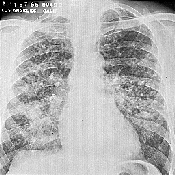

EXPERIMENT #5:
RADIOGRAPHY
Introduction
This is a basic x-ray showing the thoracic region of the body (chest). An x-ray is one type of radiographic picture.
 |
Radiography is the production of an image on photographic film created from a radiation source. The principle is the same as taking a photograph with a camera, but radiation is substituted for light. An image is produced by ionizing radiation on the undeveloped film. When the film is processed, it can show the location and intensity of the source used and the shape of objects placed between the source and film.
Objective
To investigate the intensity of beta particles on photographic film.
Materials
- Polaroid film type 57
- Polaroid Land Film Holder #500
- Sr-90 (beta source)
- Tape
Procedure
- Place film with lens side up on a flat surface.
- Uncoil a paper clip and place it in the center of the film.
- Next, place the beta source over the clip, so that the quarter inch window is directly over the object. Carefully tape the objects to the film.
- Allow the film to absorb the radiation overnight.
- Remove the objects from the film.
- Turn select lever on film holder to "load" and load film.
- Next, turn select lever on film holder to "process" and remove film.
- Allow 60 seconds for the development of the film before removing the picture.
- Repeat the same procedures, but move the source 1 cm from the clip and film.
- For a control, repeat steps 1-8 without using a paper clip.
Data
Draw your observations.
Questions
- Why is it necessary to have a control?
- Compare the paper clip images with the control image.
- Why was there a difference in intensity?
- Would gamma radiation produce an image of the paper clip? EXPLAIN.
Going Further
- Try different types of objects, such as a plastic comb, rubber band, or string.
- Determine the maximum distances and lengths of exposure time needed to produce images of the above objects.
This document was produced by the Nuclear Science Division of the Lawrence Berkeley National Laboratory.




